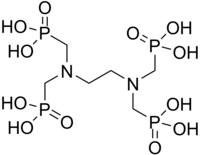
Photo from wikipedia
Abstract Benzimidazole molecules and samarium nitrate were mixed together to synergistically reduce the steel corrosion rate in simulated seawater solution. Scanning electron microscopy analysis demonstrated that in the solution containing… Click to show full abstract
Abstract Benzimidazole molecules and samarium nitrate were mixed together to synergistically reduce the steel corrosion rate in simulated seawater solution. Scanning electron microscopy analysis demonstrated that in the solution containing the mixture of inhibitive compounds (especially at 250 ppm Sm+750 ppm BI) a dense film without micro-crack uniformly deposited on the steel surface. The interaction (physical and/or chemical) between the samarium cations and benzimidazole molecules was confirmed by means of Fourier-transform infrared spectroscopy. By polarization and electrochemical impedance spectroscopy techniques, the corrosion inhibition activity of the deposited film on the steel surface was investigated. The electrochemical tests revealed the poor corrosion inhibition activity of each of inhibitors in NaCl solution, but 92% efficiency was attained in mixed form. The polarization test showed that the film of benzimidazole-samarium (III) could effectively retard the cathodic/anodic corrosion reactions on the steel surface in subjection to the chloride-containing electrolyte and decrease the corrosion current density from 8.5 to 0.7 μA/cm2.
Journal Title: Journal of Molecular Liquids
Year Published: 2019
Link to full text (if available)
Share on Social Media: Sign Up to like & get
recommendations!